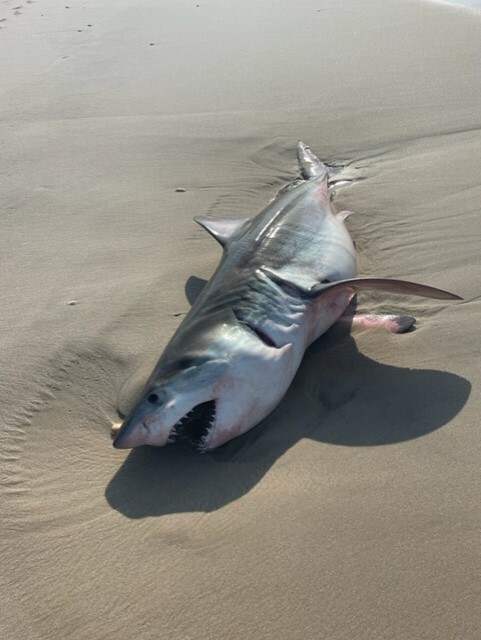
Two deceased juvenile great white sharks were discovered on South Fork beaches last week.
Quogue Village Police said a Dune Road resident reported that a dead shark washed up on the beach between 80 Dune Road and 90 Dune Road on Wednesday, July 20, though the shark was washed back out to sea before it could be collected.
Then, the next day, a beach walker found a great white shark on Dune Road between Hampton Bays and East Quogue, and that shark was collected for examination.
The first shark, Quogue Village Police said, was reported to be between 7 and 8 feet long. Police advised swimmers and boaters to be aware of the situation and keep a distance. They noted that they have been in contact with the South Fork Natural History Museum Shark Research and Education Program.
Frank Quevedo, the executive director of the South Fork Natural History Museum in Bridgehampton, said his team went down to the beach and expected the shark to wash back to shore when the tide came in. However, by the next day it had not reappeared.
Quevedo’s team had planned to perform a necropsy — an autopsy for animals — on the shark. He said dead sharks are of particular value to researchers. “Dead sharks provide more information to us,” he said. “We can analyze parts of the anatomy that we can’t with a live shark.”
He said the shark is a sub-adult and not reproductively mature yet.
While some who have seen photos of the great white suspect that it is a different species of shark, like a porbeagle or salmon shark, Quevedo said it is definitely a white shark.
White sharks are a federally protected species, he pointed out, saying his team has all of the necessary permits to collect the shark and necropsy it.
Katrina Winsor came across a great white about 1,000 feet east of Hot Dog Beach the following day, though it was not the same shark.
“I was just walking with some of my dogs on the beach,” she recalled later that day. “I came across it a little bit before 8 o’clock in the morning.”
The shark was tumbling in the surf, clearly dead. A man pulled it up the beach so it wouldn’t be taken back out.
Winsor called Southampton Town Police, who sent marine patrol officers who towed the shark off the beach.
She had spoken to other beach walkers who said they saw the shark the day before. It appeared to be alive then, and they pushed it back out to sea.
The shark was 5, maybe 6, feet long, Windsor said. Based on the teeth, she’s certain it was a great white shark. “A lot of times you can tell sharks species by their teeth,” she noted.
She also said it was male because it had two appendages right by the pelvic fins called claspers, which only male sharks have.
Though she hasn’t worked with sharks directly, the Flanders resident knows quite a bit about sharks from the years she worked at the Long Island Aquarium in Riverhead, where she was a marine mammal trainer.
Quevedo said the State Department of Environmental Conservation took the shark for a necropsy, and when examiners opened the shark’s stomach, it was empty. It must have been sick and not eating, he said. He explained that the shark would be cut into pieces to be sent to laboratories around the country for analysis.
Quevedo said increased shark sightings are a reflection of conservation efforts. He pointed out that protections for Atlantic menhaden, or bunker, in New York waters have resulted in an increased population of the fish, and the sharks followed.
“Sharks roam the ocean looking for food,” she said. “That’s all they do: look for food and have offspring.”
In addition to sharks, the menhaden feed ospreys, eagles, whales, dolphins, seals, striped bass and bluefish, he said.
Quevedo also noted that the ocean waters off Long Island are a great white shark nursery and satellite tags show juveniles spend many months there before heading south.
“It’s a nursery,” he said. “They are using this area to develop. It’s not like they’re just passing through.”
He emphasized that great white sharks are necessary for the health of the marine environment. “We’re very fortunate that one of the top apex predators on the planet uses the South Shore of Long Island,” he said. “I can’t tell you how much that means to an ecologist.”
The South Fork Natural History Museum and OCEARCH have tagged more than 30 great white sharks since 2015, he said.
“Now we’re targeting a different species of shark through a grant with Stony Brook University,” he added. The new effort targets sand tigers sharks, sandbars sharks and dusky sharks. “All three are prohibited species — they’re New York State protected,” Quevedo said.